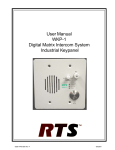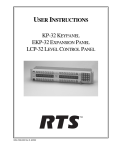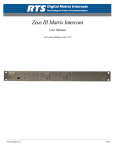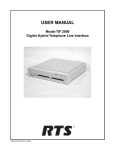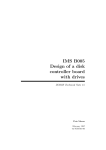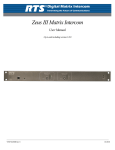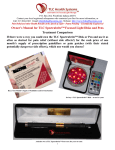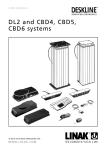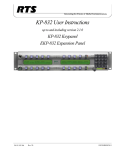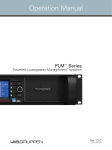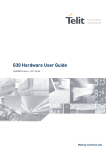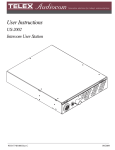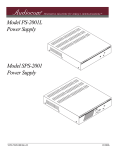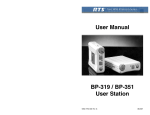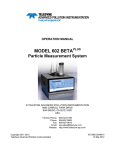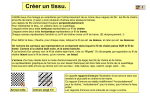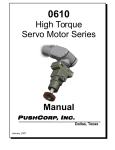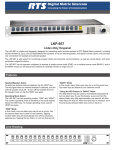Download KP-12 Keypanel Kits Installation Instructions
Transcript
INSTALLATION INSTRUCTIONS KP-12 KEYPANEL KITS 9330-7497-003 Rev B 05/2004 2 PROPRIATARY NOTICE The RTS product information and design disclosed herein were originated by and are the property of Telex Communications, Inc,, Telex reserves all patent, proprietary design, manufacturing, reproduction, use and sales rights thereto, and to any article disclosed therein, except to the extent rights are expressly granted to others. COPYRIGHT NOTICE Copyright 2004 by Telex Communications, Inc. All rights reserved. Reproduction in whole or in part without prior written permission from Telex is prohibited. UNPACKING AND INSPECTION Immediately upon receipt of the equipment, inspect the shipping container and the contents carefully for any discrepancies or damage. Should there be any, notify the freight company and dealer at once. TECHNICAL SUPPORT Technical questions should be directed to: Factory Service Department Telex Communications, Incorporated West 1st Street Blue Earth, MN 56013 U.S.A RETURN SHIPPING INSTRUCTIONS Procedure for returns If a repair is necessary, contact the dealer where the unit was purchased. If repair through the dealer is not possible, obtain a RETURN AUTHORIZATION from: Customer Service Department Telex Communications, Inc. Telephone: 800-392-3497 Fax: 800-323-0498 DO NOT RETURN ANY EQUIPMENT DIRECTLY TO THE FACTORY WITHOUT FIRST OBTAINING A RETURN AUTHORIZATION. Be prepared to provide the company name, address, phone number, a person to contact regarding the repair, the type and quantity of equipment, a description of the problem and the serial number(s). SHIPPING TO MANUFACTURER FOR REPAIR OR ADJUSTMENT All shipments of RTS products should be made via United Parcel Service or the best available shipper, prepaid. The equipment should be shipped in the original packing carton; if that is not available, use any suitable container that is rigid and of adequate size. If a substiture container is used, the equipment should be wrapped in paper and surrounded with at least four incesh of excelsior or similar shockabsorbing material. All shipments must be sent to the following address and must include the Return Authorization. Factory Service Department Telex Communications, Incorporated West 1st Street Blue Earth, MN 56013 USA Upon completion of any repair the equipment will be returned via United Parcel Service or specified shipper collect. 3 End user License Important! Please read this document carefully before using this product. THIS DOCUMENT STATES THE TERMS AND CONDITIONS UPON WHICH TELEX COMMUNICATIONS, INC, (the “COMPANY”) OFFERS TO LICENSE THE INSTALLED SOFTWARE OR PROGRAM (the “SOFTWARE) FOR USE WITH THE PRODUCT IN WHICH IT WAS INSTALLED. YOU ARE AGREEING TO BECOME BOUND BY THE TERMS OF THIS AGREEMENT. IF YOU DO NOT AGREE TO THE TERMS OF THIS AGREEMENT, DO NOT USE THIS PRODUCT. PROMPTLY RETURN THE PRODUCT TO THE PLACE WHERE YOU OBTAINED IT FOR A FULL REFUND. The installed software as supplied by the Company is licensed, not sold, to you for use only under the terms of this license, and the Company reserves all rights not expressly granted to you. You own the product or other media on or in which the Software is originally or subsequently recorded or fixed, but the Company retains ownership of all copies of the Software itself. 1. License: this license allows you to use the Software for internal purposes only on a single product in which it is installed. 2. Restrictions: (a) You may not market, distribute or transfer copies of the Software to others or electronically transfer or duplicate the Software. YOU MAY NOT REVERSE ENGINEER, DECOMPILE, DISASSEMBLE, MODIFY, ADAPT, TRANSLATE, RENT, LEASE OR LOAN THE SOFTWARE OR CREAT DERIVATIVE WORKS BASED ON THE SOFTWARE OR ANY ACCOMPANYING WRITTEN MATERIALS. (b) The Software and the accompanying written materials are copyrighted. Unauthorized copying of the Software, including portions thereof or the written materials, is expressly forbidden. (c) You understand that the Company may update or revise the Software and in so doing incurs no obligation to furnish such updates to you. 3. Limited Warranty: The Company does not warrant that the operation of the Software will meet your requirements or operate free from error. The Company DISCLAIMS ALL OTHER WARRANTIES AND CONDITIONS EITHER EXPRESS OR IMPLIED, INCLUDING THE WARRANTIES OF MERCHANTABILITY, FITNESS FOR A PARTICULAR PURPOSE AND NON-INFRINGEMENT OF THIRD PARTY RIGHTS. 4. Limited Liability: The liability of the Company for any claims arising out of this License based upon the Software, regardless of the form of action, shall not exceed the greater of the license fee for the Software or $50.00. 4 Contents 1 INTRODUCTION ..............................................................................................................................6 2 COMPONENTS OF A KP-12 INTERCOM STATION ........................................................................6 2.1 Control and Audio Receive PC Board .....................................................................................7 2.2 Audio Transmit PC Board .........................................................................................................7 2.3 Dual Shaft Encoder and Dual Display PC Boards ...................................................................8 2.4 Key Modules ............................................................................................................................8 2.5 General Purpose Interface Module GPI) ..................................................................................9 2.6 Connector Module ...................................................................................................................9 2.7 Power Entry Module .................................................................................................................9 2.8 Frame Interconnect Module .....................................................................................................9 2.9 Power Supply PC Board ..........................................................................................................9 2.9.1 Power Supply Specifications ........................................................................................10 3 KIT PARTS LISTS ..........................................................................................................................11 3.1 KP12-SP Intercom Station Kit with 12 Alpha-Numeric Pushbutton Keys ...............................11 3.2 KP12-SL Intercom Station Kit with 12 Alpha-Numeric Lever Keys .........................................11 3.3 KPM-BASE-S Base Component Kit .......................................................................................11 3.4 KPM-P4 Pushbutton Kit, 4 Pushbuttons without Displays ......................................................12 3.5 KPM-P4A Pushbutton Kit, 4 Pushbuttons with Alpha-Numeric Displays ...............................13 3.6 KPM-L4 Lever Key Kit, 4 Lever Keys without Displays...........................................................13 3.7 KPM-L4A Lever Key Kit, 4 Lever Keys with Alpha-Numeric Displays ....................................13 3.8 KPM-IO General Purpose Input/Output (GPI) Module Kit .......................................................14 3.9 KPM-CK Audio Connector Kit ................................................................................................14 4 Dimensions and Cutouts ................................................................................................................15 5 1 INTRODUCTION This manual describes the assembly of custom intercom keypanels using kits based on the RTS™ Systems’ KP-12 Intercom Keypanel. Typical applications of these kits could include desktop intercom stations, wall- or panel-mounted intercom stations, rack-mounted intercom stations and hybrid stations that integrate an intercom station into other equipment. The manual contains a brief description of the KP-12 design concept and the general requirements of an intercom station based on this design. Other general design and construction requirements also discussed, such as case materials and additional tools and hardware required to supplement the kits. This is followed by detailed descriptions and specifications, such as dimensions, hole cutout requirements etc., for the various components. Finally, a general procedure is suggested for connecting the components and checking operation. An intercom station constructed using the standard kit components will operate as described in the KP-12 User Instructions which are included with the kits. 2 COMPONENTS OF A KP-12 INTERCOM STATION Figure 1 shows the main components and their relative positions in a standard KP-12 Keypanel with all options installed. This figure is provided for reference purposes only; custom keypanels can have many different layouts. For example, the KP-12 has 12 intercom keys arranged in a single row; a custom keypanel could have up to 48 keys (if no GPI Module is installed) arranged in several rows. The KP-12 may be optionally equipped with a back panel connector module; a custom keypanel design could use a different arrangement of connectors or eliminate these connectors if they are not required. A gooseneck microphone connector, a speaker, and a headset connector are all provided on the front panel of the KP-12; if a custom keypanel will be used as a headset station only, and space is at a premium, the gooseneck microphone connector and the speaker could be eliminated. In the KP-12, the circuit boards are positioned to permit a rack-mount design only one rack unit high; a custom desktop intercom station may need to occupy less horizontal space. In this situation, one or more circuit boards could be mounted on the sides of the case. Or, the Audio Receive and Audio Transmit boards could be stacked one on top of the other to occupy less space. The following paragraphs provide detailed descriptions of the major components. Figure 1. KP-12 Reference View for Typical Layout of Components 6 2.1 Control and Audio Receive PC Board This circuit board contains the CPU (central processing unit) for the intercom station. It also contains the EPROM (eraseable programmable read-only memory) which defines the keypanel operation and RAM (random access memory) which stores the current configuration information for the keypanel, including the current key assignments and the keypanel’s current address within the intercom system. The Control and Audio Receive circuit board also contains two serial control interfaces. One is an RS-485 interface for communication with the intercom system. The other interface is an I2C communication system, which uses a common bus (in this case, a ribbon cable) to exchange control information between the CPU and the other devices within the intercom station itself. In the I2C system, each device has a unique address, and all control information that is sent and received by the devices is coded with this address to assure that it arrives at the correct location. Table 1 summarizes how I2C devices are allocated within the keypanel. The I2C bus has a limit of 15 devices. This limit only becomes an issue when a large number of Key Modules are connected. For example, a fully optioned keypanel (includes a GPI module). is limited to 44 talk/listen keys (11 Key Modules, with 4 keys per module). The Control and Audio Receive PC board also contains all audio circuitry required for a listen-only intercom station. This includes a balanced intercom channel audio input, a balanced program input (to monitor a local audio source only) a 24-watt speaker amplifier, and a headphone amplifier. the speaker amplifier can drive an internal loudspeaker, as well as an optional speaker output at the back panel. 2.2 Audio Transmit PC Board The Audio Transmit PC Board adds talk-back capability to the intercom station. It contains the following: • • • • • • an electret mic input two balanced, dynamic-mic inputs a balanced, unswitched mic pre-amp output (hot mic) a balanced intercom audio output a tone generator a sidetone output Figure 3. Audio Transmit PC Board Figure 2. Control and Audio Receive PC Board Table 1. I2C Device Allocation Ci r c u i t B o ar d o r Mo d u l e Nu m b er o f I2C Dev i c es Control and Audio Receive PC Board 1 Audio Transmit PC Board 1 Dual Encoder Assembly 1 General Pur pose Interface (GPI) Module 1 Talk/Listen Key Module (four keys per module) 1 Fram Interconnect Module 1 The mic inputs provide the flexibility of using either electret or dynamic type microphones. The mic preamp output is a “hot mic” signal that can be sent to other equipment. This allows the station operator to use a common microphone to talk to multiple audio systems. The balanced intercom audio output sends the signal from the currently selected mic input to the intercom matrix. The tone generator can be used to check the audio path from the keypanel to the intercom matrix and back. The sidetone circuit feeds a portion of the microphone signal back into the audio receive circuits on the Control and Audio Receive Board. In this way, the station operator can hear his or her own voice in the headphones when using a headset. The I2C device on the Audio Transmit board consists of electronic switches by which the CPU selects the desired mic source and turns the tone generator on or off. This I2C device is simply a passive recipient of control information. It does not send any control signals back to the CPU. The 7 Audio Transmit PC Board also contains a balanced intercom line driver which sends the currently selected mic signal, and the tone generator output, if active, back to the intercom system. 2.3 Dual Shaft Encoder and Dual Display PC Boards thick (2.03mm) panel material, this spacing will cause the front surface of the alpha-numeric displays to be just behind the front surface of the front panel. Refer to the KP-12 User Manual for information about the operation of the shaft encoders. 2.4 The Dual Shaft Encoder PC Board assembles to the Display PC Board. The two assembled boards provide the following capabilities: • • • • access to the keypanel’s menu-driven program ming system independent volume adjustment for speaker output, headphone output, and the auxilliary program audio input caller identification for incoming calls, with talkback capability access to the telephone support features ncluding manual dialing, auto-dialing and redialing. (Requires an optional TIF-2000 Telephone Interface) The Dual Shaft Encoder Board contains two, multiposition rotating shaft encoder switches. Each shaft encoder also has momentary push-button contacts. The Display Board contains two, four-character alpha-numeric displays, five status LEDs, and a 16segment LED volume display. The Display Board plugs into the shaft encoder board and is secured by washers and nuts on the shaft encoders. There are five small light pipes for LEDs and a larger light pipe for the volume display. The entire assembly is designed for mounting through the front panel of the intercom station. The volume display light pipe provides the spacing between the assembled boards and the intercom case. With .080-inch Figure 4. Dual Shaft Encoder and Dual Display PC Boards 8 Key Modules Each key module provides four, talk/listen keys, with a choice of pushbutton or lever keys, with and without four-character, alpha-numeric displays. Each key module is supplied with a plastic support that provides spacing behind the front panel. With .080-inch thick (2.03mm) panel material, this spacing will cause the front surface of the alpha-numeric displays to be positioned just behind the front surface of the front panel. Refer to the KP-12 User Manual for information about the operation ofthe keys and displays. Figure 5. Lever Key Module Components Figure 6. Pushbutton Key Module Components 2.5 General Purpose Interface Module (GPI) The GPI Board provides a means of controlling external devices from the keypanel and of controlling the keypanel from external devices. The GPI Module contains the following: • • • two DPDT relays, each with two available pairs of normal-open, normal-closed and common contacts two open collector outputs capable of directly driving TTL or CMOS inputs four opto-isolated inputs capable of being driven by TTL or CMOS devices 2.7 Power Entry Module The power entry module provides a universal power cord connector, fuse, and on/off switch. 2.8 Frame Interconnect Module The Frame Interconnect Module provides intercom system connectors. There is also an expansion connector for connection of an EKP-Series expansion panel. 2.9 Power Supply PC Board This versatile, switching type power supply is suitable for Figure 7. GPI Module Figure 10. Frame Interconnect Module 2.6 Connector Module The connector module provides: • • • • An external dynamic-mic input An external line input for connection of a local audio source A mic preamp output connector which can be turned off via the dual shaft encoder A connector for an external dynamic-mic headset. This connector may also be used with an external electret mic when a front panel speaker or an external speaker is being used. use with AC input voltages from 47 to 260 VAC and 47 to 63Hz. The power supply has enough rated capacity to power all of the base circuitry plus a few extra modules. For example, if a GPI module is not used, up to 6 key modules (24 talk/listen keys) may be installed. If more key modules are required, a suitable power supply providing the same output voltages, but with higher capacity, will have to be substituted. Figure 8. Connector Module Figure 9. Power Supply PC Board 9 2.9.1 Power Supply Specifications AC Input Voltage: 90 to 260 VAC AC Frequency: 47 to 63 Hz AC Input Current (RMS): 0.8 A at 115 VAC; 0.4 A at 230 VAC DC Outputs: See Table 2 Efficiency: 70% typical at full load Hold-up Time: 16 msec typical at full load and 115 VAC input Overcurrent Protection: All outputs equipped with automatic recovery current limiting circuit Overvoltage Protection: 5.6 V to 6.5 V on main output Table 2. Power Supply Ratings (Any substituted supply must meet or exceed the ratings for Ripple and Total Tolerance) L o ad Ou t p u t Vo l t ag e Ri p p l e (P-P) To t al To l er an c e Ou t p u t Pi n s Mi n Max @20 CFM Peak +5.1V 0.3A 2.0 A 4.0 A 5.0 A 50mV ±2% 2,3 +12 V 0.1 A 1.0 A 1.5 A 2.0 A 120 mV ±5% 1 -12 V 0.0 A 0.3 A 0.3 A 0.5 A 120 mV ± 5% 6 Table 3. Module Maximum Current Requirements Mo d u l e +5.1 VDC +12 VDC -12 VDC Control and Audio Receive 80 mA 145 mA 80 mA Audio Transmit 6 mA 25 mA 45 mA Dual Encoder and Dual Display 175 mA 0 mA 0 mA Key Modules 305 mA 0 mA 0 mA GPI Modules 250 mA 0 mA 0 mA 3 mA 0 mA 0 mA Frame Interconnect 10 3 KIT PARTS LISTS 3.1 KP12-SP Intercom Station Kit with 12 Alpha-Numeric Pushbutton Keys Kit Part Number 9000-7497-003 This kit contains the basic componenets for an intercom station with 12 pushbutton style intercom keys. Items not supplied: case, component mounting hardware, and matrix interconnect cables. Qu an t i t y 3.2 Des c r i p t i o n Par t Nu m b er 1 KPM-BASE-S Base Component Kit (Includes installation instructions) 9010-7497-010 3 KPM-P4A Pushbutton Kit, 4 Pushbuttons with Alpha-Numeric Displays 9010-7497-005 1 KP-12 User Instructions, Pushbutton Version (Rev E or later) 9350-7497-001 KP12-SL Intercom Station Kit with 12 Alpha-Numeric Lever Keys Kit Part Number 9000-7497-004 This kit contains the basic components for an intercom station with 12 lever style intercom keys. Items not supplied: case, component mounting hardware, and matrix interconnect cables. Qu an t i t y Des c r i p t i o n Par t Nu m b er 1 KPM-BASE-S Base Component Kit (Includes installation instructions) 9010-7497-010 3 KPM-L4A Lever Key Kit, 4 Lever Keys with Alpha-Numeric Displays 9010-7497-006 1 KP-12 User Instructions, Lever Key Version (Rev B or later) 9350-7497-002 3.3 KPM-BASE-S Base Component Kit Part Number 9000-7497-010 This kit contains the basic components for an intercom station. Pushbutton or lever key kits are required to complete the intercom station. Items not supplied: case, component mounting hardware, and matrix interconnect cables. 11 Qu an t i t y Des c r i p t i o n Par t Nu m b er 1 PC Board Assembly, Control and Audio Receive 9030-7725-000 1 PC Board Assembly, Audio Transmit 9030-7725-500 1 PC Board Assembly, Matrix Frame Interconnect 9030-7506-000 1 PC Board Assembly, Power Supply 532024-000 1 PC Board Assembly, Dual Display 9030-7508-000 1 PC Board Assembly, Dual Encoder 9030-7709-500 1 Light Pipe, Volume Indicator for Dual Encoder 700501-000 5 Light Pipe, Call, Menu, Hdst, Spkr, Prgm Indicators for Dual Encoder 700502-000 2 Knob, Select and Volume for Dual Encoder 590218-000 1 Speaker and Wire Connector Assembly 1 Bushing, Gooseneck Mic Connector 9160-7028-001 1 Bushing, Gooseneck Mic Connector 700678-000 1 Lock Washer, Gooseneck Mic Connector Mounting 585025-000 1 Nut, 5/8 - 18, Gooseneck Mick Connector Mounting 585016-000 1 Gooseneck Mic Jack and Wire Connector Assembly 800162-000 1 Headset XLR4RF Panel Mount Connector and Wire Connector Assembly 800163-000 2 800169-000 1 Cable, Ribbon, 5ft. (1.5 m), I C Bus Signal and Power Distribution 57799-001 5 I2C Ribbon Cable Connector, 10 Pin 57739-001 1 Cable Assembly, Frame Interconnect to Audio Receive and Transmit Boards 800166-000 1 Cable Assembly, Audio Receive and Transmit Board Power Distribution 800167-010 1 Cable Assembly, Sidetone 800212-000 1 KP-12 Custom Keypanel Kit Instructions 1 Cable, Ribbon, 6 inches (digital control for compression) 9330-7497-003 800168-003 3.4 KPM-P4 Pushbutton Kit, 4 Pushbuttons without Displays Kit Part Number 9000-7497-011 This kit is intended for used with the KPM-BASE-S Kit. Each pushbutton kit adds 4 pushbutton intercom keys. Also order one copy of KP-12 User Instructions, Pushbutton Version (specify Rev E or later) part number 9350-7497-0001. Quantity 12 Description Par t Number 1 PC Board Assembly, 4 Pushbutton, No Display 9030-7708-014 1 PC Board Suppor t, Pushbutton 9110-7497-000 2 Nut, 4-40 50033-022 1 I2C Ribbon Cable Connector, 10 Pin 57739-001 3.5 KPM-P4A Pushbutton Kit, 4 Pushbuttons with Alpha-Numeric Displays Kit Part Number 9000-7497-005 This kit is intended for use with the KPM-BASE-S Kit. Each pushbutton kit adds 4 pushbutton intercom keys. Also, order one copy of KP-12 User Instructions, Pushbutton Version (specify Rev E or later) part number 9350-7497-001. Quantity 3.6 Description Par t Number 1 PC Board Assembly, 4 Pushbuttons, 4 Alpha-Numeric Displays 9030-7708-004 1 PC Board Suppor t, Pushbutton 9110-7497-000 2 Nut, 4-40 50033-022 1 I2C Ribbon Cable Connector, 10 Pin 57739-001 KPM-L4 Lever Key Kit, 4 Lever Keys without Displays Kit Part Number 9000-7497-012 This kit is intended for use with the KPM-BASE-S Kit. Each lever key kit adds 4 intercom keys. Also order one copy of the KP-12 User Instructions, Lever Key Version (specify Rev B or later) part number 9350-7497002. Quantity 3.7 Description Par t Number 1 PC Board Assembly, 4 Pushbuttons, No Display 9030-7708-018 1 PC Board Suppor t with Pin, Lever Key 9110-7497-001 2 Nut, 4-40 50033-022 1 I2C Ribbon Cable Connector, 10 Pin 57739-001 4 Lever Key 700504-000 4 Light Pipe, Lever Key 700499-000 KPM-L4A Lever Key Kit, 4 Lever Keys with Alpha-Numeric Displays Kit Part Number 9000-7497-006 This kit is intended for use with the KPM-BASE-S Kit. Each lever key kit adds 4 intercom keys. Also order one copy of KP-12 User Instructions, Lever Key Version (specify Rev B or later) part number 9350-7497-002. Qu an t i t y Des c r i p t i o n Par t Nu m b er 1 PC Board Assembly, 4 Lever Key, 4 Alpha-Numeric Display 9030-7708-008 1 PC Board Suppor t with Pin, Lever Key 9110-7497-001 2 Nut, 4-40 50033-022 1 I2C Ribbon Cable Connector, 10 pin 57739-001 4 Lever Key 700504-000 4 Light Pipe, Lever Key 700499-000 13 3.8 KPM-IO General Purpose Input/Output (GPI) Module Kit Kit Part Number 9000-7497-022 NOTE: This kit should not be ordered for use on a factory-built KP-12, since it is not equipped with the required mounting plate and spacers. Qu an t i t y 3.9 Des c r i p t i o n 1 BPI Assembly, 4 Relays, 2 Open Collector Outputs, 4 Opto-Isolator Inputs 1 I2C Ribbon Cable Connector, 10 pin Par t Nu m b er 9020-7505-000 57739-001 KPM-CK Audio Connector Kit Kit Part Number 9000-7497-023 This kit contains pre-wired connector assemblies for external connection of microphone, speaker, program input, unswitched balanced mic preamp output, and dynamic-mic headset. This kit should not be ordered for use on a factory-built KP-12, since it is not equipped with the required mounting plate and spacers. Qu an t i t y Des c r i p t i o n Par t Nu m b er 1 Connector Panel Assembly, with 3-Conductor 1/4-inch Phone Jack (Speaker), DE9P Connector (Headset), and 3 XLR3F Audio Connectors (Mic Preamp Out, Program In., Ext. Mic. In.). Includes Wire Connectors to PC Boards 9020-7497-002 14 4 Dimensions and Cutouts 5.200 (132.08) 3.421 (86.89) 0.218 (5.54) 2.000 (50.80) 1.045 (50.80) 0.871 (22.12) .125 DIA. (3.17 DIA.) 0.953 (24.21) 0.062 (1.57) INCHES (MILLIMETERS) 0.845 (21.46) NOT TO SCALE Figure 11. Control and Audio Receive PC Board Dimensions (Not shown to scale) 0.953 (24.21) 5.200 (132.08) 0.830 (21.08) 2.000 (50.80) 1.045 (26.54) .125 DIA. ( 3.18) 0.871 (22.12) 3.421 (86.89) INCHES (MILLIMETERS) BETWEEN MOUNTING HOLE CENTERS NOT TO SCALE Figure 12. Audio Transmit PC Board Dimensions (Not shown to scale) 15 2.594 (65.89) 0.443 (11.25) 0.062 (1.57) 0.984 (24.99) 1.825 (46.36) 1.000 (25.40) 1.560 (39.62) INCHES (MILLIMETERS) 0.413 (10.46) NOT TO SCALE Figure 13. Dual Shaft Encoder PC Board Dimensions (not to scale) INCHES (MILLIMETERS) 1.850 (46.99) 0.367 (9.32) 0.900 (22.86) .125 DIA. (3.18) 1.560 (39.62) 0.735 (18.67) 0.485 (12.32) 0.400 (10.16) 1.000 (25.40) .300 DIA. (7.62) NOT TO SCALE Figure 14. Dual Display PC Board Dimensions (not to scale) 16 0.062 (1.57) 17 .270 DIA. (6.86) 0.557 0.488 (14.15) (12.40) 0.408 (10.36) 0.358 (9.09) 1.000 (25.40) 0.815 (20.70) 0.500 (12.70) 1.800 (45.72) 1.850 (46.99) Figure 15. Cutout Dimensions for the Dual Display PC Board (scale not assured) SCALE NOT ASSURED 0.957 (24.31) .125 DIA. (3.18) INCHES (MILLIMETERS). 68° .050 R. (1.27) 0.450 (11.43) 0.485 (12.32) 1.560 (39.63) (7.42) .292 R. .392 R. (9.96) DISPLAY BOARD OUTLINE INCHES (MM) 0.826 (20.98) 3.304 (83.92) 1.652 (41.97) 1.560 (39.62) 0.367 (9.32) 0.062 (1.57) 0.909 (23.09) 0.138 (3.51) .125 DIA. (3.18) .250 MAX. DIA. STAND-OFF (6.35) 3.294 (83.67) 0.821 (20.85) 0.320 (8.13) 1.652 (41.96) 0.755 (19.18) NOT TO SCALE Figure 16. Lever Key PC Board Dimensions (not to scale) 18 0.400 (10.16) 0.170 (4.32) 0.104 (2.64) 3.304 (83.92) 0.826 (20.98) 0.590 (14.99) 1.652 (41.97) 1.560 (39.62) 0.366 (9.32) 0.909 (23.08) 0.062 (1.57) .125 DIA. (3.18) 0.400 (10.16) .250 MAX DIA. STAND-OFF (6.35) 3.294 (83.67) 0.821 (20.85) 0.320 (8.13) 1.652 (41.96) 0.755 (19.18) NOT TO SCALE Figure 17. Pushbutton Key PC Board Dimensions (not to scale) 19 20 INDICATES BOARD OUTLINE (41.96) (20.98) (83.92) 3.304 1.652 0.826 (12.37) 0.487 .706 SQ. CUT OUT (17.93 SQ.) (4 PLS) (8.53) 0.336 (2.87) .113 DIA. SCALE NOT ASSURED (20.98) (TYP) 0.826 .706 X .400 CUT OUT (17.93 X 10.16) (4 PLS) Figure 18. Panel Cutout Dimensions for Lever Key PC Board and Pushbutton PC Board (scale not assured) (39.62) 1.560 (16.53) 0.651 (10.16) 0.400 INCHES (MM) 21 (41.96) 1.652 MIN. SCALE NOT ASSURED Figure 19. Minimum Hole Spacing Requirement for Side by Side and Above/Below Key Board Placement (Scale not assured) (42.16) 1.660 MIN. INDICATES BOARD OUTLINE 2.650 INCHES (MM) (67.31) 0.019 1.900 (.48) (48.26) 1.150 1.043 (29.21) (26.49) 2.170 NOT TO SCALE (55.12) Figure 20. Power Entry Module Dimensions (not to scale) 2.600 (66.04) INCHES (MM) 1.063 (27.00) SCALE NOT ASSURED Figure 21. Power Entry Module Panel Cutout Dimensions (scale not assured) 22 3.000 (76.20) 4.000 (101.60) INCHES (MILLIMETERS) 3.600 (91.60) .160 DIA. (4.06) 2.600 (66.04) 0.200 (5.08) 1.300 0.200 (5.08) (33.02) NOT TO SCALE Figure 22. Power Supply PC Board Dimensions (not to scale) 2.650 (67.31) 0.530 (13.47) 1.400 (35.56) 1.272 (32.30) INCHES (MILLIMETERS) 0.062 (1.57) 0.400 (10.16) NOT TO SCALE Figure 23. Frame Connector Module Dimensions (not to scale) 23 .750 DIA. (19.05) 1.738 (44.15) 0.087 (2.21) INCHES (MILLIMETERS) 0.625 (15.88) 0.693 (17.60) NOT TO SCALE Figure 24. Gooseneck Microphone Connector Dimensions (not to scale) INCHES (MILLIMETERS) 0.077 (1.95) .299 R (2 PLS) (7.60) 0.575 (14.60) BUSHING OUTLINE .750 DIA. (19.05) SCALE NOT ASSURED Figure 25. Gooseneck Microphone Connector Panel Cutout Dimensions (scale not assured) 24 INCHES (MILLIMETERS) 1.419 (36.04) 0.374 1.220 0.091 (9.50) (30.99) (2.31) 1.060 0.748 (26.92) (19.00) 0.473 NOT TO SCALE 0.945 (12.00) (24.00) Figure 26. XLR Connector Dimensions (not to scale) INCHES (MILLIMETERS) .138 DIA. (3.51) 0.944 (23.98) 0.748 (19.00) XLR CONNECTOR OUTLINE 0.374 (9.50) 0.472 (11.99) 1.220 (30.99) 0.137 (3.48) .945 DIA. 0.156 (3.96) (24.00) SCALE NOT ASSURED 1.060 (26.92) Figure 27. XLR Connector Panel Cutout Dimensions (scale not assured) 25 5.421 (137.69) 3.310 (84.07) 0.453 (11.51) 2.207 (56.06) 0.062 (1.57) 0.400 (10.16) 1.500 (38.10) 1.103 (28.02) 4.413 (112.09) INCHES (MILLIMETERS) 0.400 (10.16) NOT TO SCALE Figure 28. GPI Module Dimensions (not to scale) 1.615 1.049 (41.02) (26.64) 2.795 2.495 (70.99) (63.37) INCHES (MILLIMETERS) 1.315 (33.40) NOT TO SCALE 29. Speaker Dimensions (not to scale) 26 27 0.653 (16.59) 2.795 (70.99) 1.190 (30.23) SCALE NOT ASSURED Figure 30. Speaker Cutout Dimensions (scale not assured) 0.150 (3.81) .150 (3.81) 1.615 (41.02) .625 R. (15.88) 2.496 (63.40) INCHES (MILLIMETERS) .125 DIA. (3.18) 0.658 (16.70) SPEAKER OUTLINE 1.315 (33.40) 1 2 3 1 2 3 4 5 6 MATRIX DATA + MATRIX DATA - 1 2 3 4 5 6 +12VDC +5.1VDC NC COMMON COMMON -12VDC PIN 1 J1 NC 1 2 3 J1 NC 1 2 3 J1 J3 J4 J10 NC J1 PIN 1 1 2 3 4 5 CONTROL AND AUDIO RECEIVE PC BOARD (7725-000) J2 TALK/LISTEN KEY MODULES AUDIO FROM MATRIX + AUDIO FROM MATRIX - AUDIO TO MATRIX + AUDIO TO MATRIX - POWER SUPPLY PC BOARD 9 4 5 3 8 7 6 1 2 10 NC J3 FRAME INTERCONNECT MODULE PIN 1 Figure 31. KP-12 Matrix, I2C and Power Connections 1 2 3 CHASSIS EARTH GROUND AC LINE (L) AC NEUTRAL (N) POWER ENTRY MODULE J1 GPI MODULE 1 2 3 4 5 J3 J1 J6 2 1 J7 3 2 1 3 J8 2 1 J9 3 2 1 1 2 J4 J2 J1 DUAL ENCODER AND DISPLAY MODULES J5 NC 1 2 3 2 J7 J6 J5 1 2 3 4 5 2 I C CABLE J9 PIN 1 J8 J3 ALL I C CONNECTORS AUDIO TRANSMIT PC BOARD (7725-500) PIN 1 1 2 3 PIN 1 1 2 3 1 2 3 1 2 3 1 2 3 1 2 3 1 2 3 1 2 3 4 5 1 2 3 1 2 3 28 1 2 3 3 2 1 LINE IN LINE IN + NC J1 J2 3 2 1 J3 PIN 1 J8 1 2 1 2 1 2 3 1 2 3 1 2 3 J9 1 2 3 4 5 1 2 3 J7 DYNAMIC MIC + DYNAMIC MIC - HEADPHONE HEADPHONE + 1 2 J6 1 2 3 AUDIO TRANSMIT PC BOARD (7725-500) J5 1 2 3 1 2 J4 1 2 3 4 5 J10 3 2 NC 1 CONTROL AND AUDIO RECEIVE PC BOARD (7725-000) 1 2 3 PIN 1 J6 2 1 J7 3 2 1 3 J8 2 1 J9 3 2 1 1 2 3 1 2 3 J5 TO CHASSIS 2 1 2 1 2 1 1 2 3 1 2 3 1 2 3 J4 EXT LINE IN 3-PIN FEMALE XLR 3 2 NC 1 NC 1 2 3 J3 DYNAMIC MIC + DYNAMIC MIC - SPEAKER + SPEAKER - DYNAMIC MIC + DYNAMIC MIC HEADPHONE HEADPHONE + ELECTRET MIC + ELECTRET MIC - NC J2 MIC PRE OUT 3-PIN FEMALE XLR 3 2 1 NC 1 6 2 NC 3 4 9 5 8 7 T R S J1 EXT MIC IN 3-PIN FEMALE XLR MIC PRE OUT MIC PRE OUT + HEADSET 9-PIN MALE DSUB 3 2 1 SPKR 3-CONDUCTOR 1/4" PHONE JACK 1 2 1 2 R T S FRONT PANEL GOOSENECK MIC 3-CONDUCTOR 1/4" PHONE JACK MIC + MIC - + - FRONT PANEL DYN-MIC HEADSET 4-PIN FEMALE XLR 1 2 3 4 N/C 1 2 3 3 2 1 DENOTES CABLE SHIELD DENOTES TWISTED PAIR Figure 32. KP-12 Audio Connections 29






























